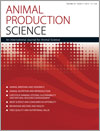
Animal Production Science
Volume 54 Number 2 2014
AN13052Climate change and broadacre livestock production across southern Australia. 3. Adaptation options via livestock genetic improvement
Increasing the forage conversion efficiency of livestock is a possible response to reduced forage supply due to changing climates across southern Australia. Modelling analyses indicate that breeding for greater fleece growth in sheep and for larger body size in cattle are effective genetic adaptation options; increasing conception rates was less effective. Genetic improvement of livestock was less effective at drier locations where the need for adaptation is likely to be greatest.
AN12233Identifying indicator traits for breech strike in Merino sheep in a Mediterranean environment
The present paper reports on a genetic study to identify indicator traits that are heritable and genetically correlated with breech strike in a Mediterranean environment. Dags, urine stain and neck wrinkle have been identified as indicator traits with the best potential to breed sheep indirectly for resistance to breech strike in a Mediterranean environment without the need to challenge animals directly with blowflies.
AN12204Reducing in vitro rumen methanogenesis for two contrasting diets using a series of inclusion rates of different additives
Cows are capable of producing 200–600 L per day of the greenhouse gas methane, an amount greater than the pollution produced daily by a family-sized car. In a laboratory experiment, we have demonstrated that some inhibitors of methane production are more effective for a cow-diet containing silage and barley than for a diet containing grass only. The present study highlighted the importance of using different feed types when assessing the methane-reduction potential of feed additives.
AN12371Nutritive value for ruminants of two herbaceous South American native legumes: Adesmia bicolor and Adesmia macrostachya
The nutrtive value of the South American native legumes Adesmia bicolor and A. macrostachya was studied at vegetative, flowering and seeding stages, compared with alfalfa at 10% flowering. A. bicolor showed a high nutritive value, even higher than that of alfalfa, which was not markedly affected by its maturity stage, whereas the nutritive value of A. macrostachya reduced as it matured.
AN12092Ensiling corn silage with different levels of a multi-species lactic acid bacteria inoculant
Homofermentative lactic acid bacteria can induce aerobic deterioration of corn silages. In this experiment applications of inoculants including both homo- and heterofermentative lactic acid bacteria improved the silage quality and prevented yeast development. Due to dominance of heterolactic fermentation in matured high dry matter corn crops, inoculating such crops with this inoculant for long time period may cause a great improvement in aerobic stability.
AN12432Separate feeding of calcium improves performance and ileal nutrient digestibility in broiler chicks
Dietary calcium binds with phytate reducing the availability of phytate-phosphorus, minerals, amino acids and energy. This study investigated and demonstrated feeding broilers low calcium diets and a separate source of calcium improved the availability of phytate-phosphorus, minerals and amino acids while maintaining skeletal integrity. Separating the intake of calcium from phytate may reduce phytate-calcium interactions improving nutrient availability and bird performance.
AN13024Effect of the duration of road transport on the physiology and meat quality of lambs
Long transportation of animals (24 h) can have a detrimental effect on animal welfare and product quality. Forty lambs were transported for 24 h and compared with 40 lambs transported for 1 h to assess consequences on animal welfare and meat quality. Results on fecal cortisol metabolites and drinking patterns show that long transportation in lambs should be considered more in terms of animal welfare than product quality, where few effects were found.
AN12128Changes in blood parameters and electroencephalogram of cattle as affected by different stunning and slaughter methods in cattle
Although all stunning procedures are not totally comfortable from the animal’s point of view, penetrative stunning is less noxious and more effective in inducing insensibility when compared to non-penetrative stunning. The study determined the effects of different mechanical stunning methods on stress-related hormones and electroencephalographic reactions in beef cattle. The method of stunning may have profound impact on the welfare of animals during slaughter.
AN12321Purification and characterisation of a phosphatidylcholine-binding protein from duck Biceps femoris muscle
The interaction between protein and phospholipids is a widespread phenomenon involving several physiological events in postmortem muscle. A novel phosphatidylcholine-binding (PC-binding) protein in duck Biceps femoris muscle was purified and characterised. The PC-binding protein has a potential role in the lipolysis of phospholipid, maintenance of membrane integrity and improvement of meat quality.
AN13041Proteolysis of meat and bone meal to increase utilisation
Meat and bone meal (MBM), an important by-product of the meat industry, is the ground, rendered remainder of farm animals after removal of the hide and meat but most is insoluble, which limits its usefulness. Defatted, milled porcine MBM was subjected to saturating amounts of trypsin, a selective protease, and subtilisin, a protease with broad selectivity. The hydrolysates are useful for a variety of food and non-food uses.
AN12311Repeatability and frequency of in-paddock sheep walk-over weights: implications for individual animal management
An emerging remote weighing system, namely walk-over weighing (WOW), provides the potential to monitor liveweight of sheep for better, timelier nutritional management. The current study investigated whether the frequency and repeatability of WOW weights were sufficient to provide reliable information for farmers to make decisions on individual sheep. Results suggest that the frequency and repeatability of WOW is, generally, insufficient for estimating the liveweight of individual sheep confidently, but may suffice to estimate the liveweight of the flock
AN12356Wild dog control impacts on calf wastage in extensive beef cattle enterprises
Beef producers are sometimes unsure whether dingoes cause significant calf loss. This paper compares calf loss in pregnancy-tested herds pastured in baited and unbaited areas on the same properties and finds that more frequent and greater calf loss occurs where dingoes are baited. Baiting appears to be unnecessary most years and counter-productive in those years when calf loss does occur.



